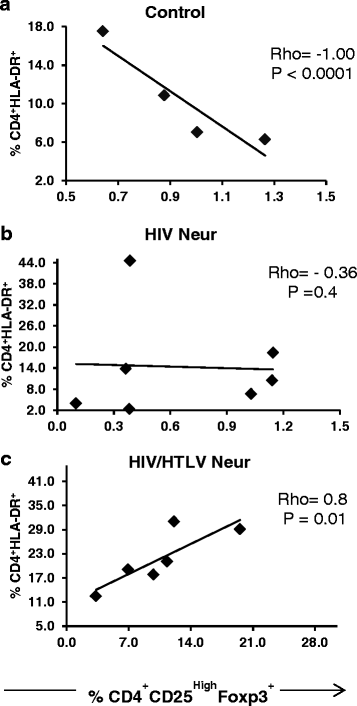CD4(+)CD25(High) Treg cells in HIV/HTLV co-infected patients with neuropathy: high expression of Alpha4 integrin and lower expression of Foxp3 transcription factor
- PMID: 26329520
- PMCID: PMC4557637
- DOI: 10.1186/s12865-015-0116-x
CD4(+)CD25(High) Treg cells in HIV/HTLV co-infected patients with neuropathy: high expression of Alpha4 integrin and lower expression of Foxp3 transcription factor
Abstract
Background: Regulatory CD4 T cells (Tregs) are critical in maintaining the homeostasis of the immune system. Quantitative or phenotypic alterations and functional impairment of Tregs have been associated with the development of pathologies including those of the central nervous system. Individuals with HIV-1/HTLV-1 co-infection are more prone to develop neurological complications. The aim of this study was to characterize phenotypically Treg cells in HIV-1/HTLV-1 co-infected Mozambican individuals presenting neurological symptoms.
Methods: A cross-sectional study was conducted among HIV-infected individuals presentingneurological symptoms, with and without HTLV co-infection, and blood donors. Peripheral bloodmononuclear cells were stained with monoclonal antibodies conjugated with fluorochromes to quantifyTregs and activated T cells by four colors flow cytometry.
Results: Higher Treg cell frequency (10.6%) was noted in HIV-1/HTLV-1 co-infected group with neurological symptoms when compared to HIV-1 mono-infected group with neurological symptoms (0.38%, p = 0.003) and control group (0.9%, p = 0.0105). An inverse correlation between Foxp3 and CD49d expression was observed in all study groups (rh = -0.71, p = 0.001). In addition, increased levels of Treg cells in co-infected patients were strongly associated with total activated CD4 T cells (rh = 0.8, p = 0.01).
Conclusion: Treg cells in co-infected patients present phenotypic alterations and might have dysfunction marked by low expression of Foxp3 and increased expression of molecules not frequently seen on Treg cells, such as CD49d. These alterations may be related to (1) changes in Treg cell trafficking and migration, possibly making those cells susceptible to HIV infection, and (2) inability to control the activation and proliferation of effector T lymphocytes.
Figures




Similar articles
-
Severe immune dysregulation affects CD4⁺CD25(hi)FoxP3⁺ regulatory T cells in HIV-infected patients with low-level CD4 T-cell repopulation despite suppressive highly active antiretroviral therapy.J Infect Dis. 2012 May 15;205(10):1501-9. doi: 10.1093/infdis/jis230. Epub 2012 Mar 28. J Infect Dis. 2012. PMID: 22457273
-
Correlation between the degree of immune activation, production of IL-2 and FOXP3 expression in CD4+CD25+ T regulatory cells in HIV-1 infected persons under HAART.Int Immunopharmacol. 2009 Jul;9(7-8):831-6. doi: 10.1016/j.intimp.2009.03.009. Epub 2009 Mar 18. Int Immunopharmacol. 2009. PMID: 19303058
-
[The subpopulation CD4(+); CD25(+); Foxp3(+);/CD127(low/-); regulatory T cells in peripheral blood of HIV-infected patients correlated with disease progression].Xi Bao Yu Fen Zi Mian Yi Xue Za Zhi. 2012 Nov;28(11):1188-91. Xi Bao Yu Fen Zi Mian Yi Xue Za Zhi. 2012. PMID: 23127412 Chinese.
-
Adult T cell leukemia/lymphoma: FoxP3(+) cells and the cell-mediated immune response to HTLV-1.Adv Cancer Res. 2011;111:163-82. doi: 10.1016/B978-0-12-385524-4.00004-0. Adv Cancer Res. 2011. PMID: 21704832 Review.
-
Immunological and Neurological Signatures of the Co-Infection of HIV and HTLV: Current Insights and Future Perspectives.Viruses. 2025 Apr 8;17(4):545. doi: 10.3390/v17040545. Viruses. 2025. PMID: 40284988 Free PMC article. Review.
Cited by
-
Human T-Lymphotropic Virus (HTLV): Epidemiology, Genetic, Pathogenesis, and Future Challenges.Viruses. 2025 May 1;17(5):664. doi: 10.3390/v17050664. Viruses. 2025. PMID: 40431676 Free PMC article. Review.
-
Trypanosoma cruzi Experimental Infection Impacts on the Thymic Regulatory T Cell Compartment.PLoS Negl Trop Dis. 2016 Jan 8;10(1):e0004285. doi: 10.1371/journal.pntd.0004285. eCollection 2016 Jan. PLoS Negl Trop Dis. 2016. PMID: 26745276 Free PMC article.
-
Helios + Regulatory T cell frequencies are correlated with control of viral replication and recovery of absolute CD4 T cells counts in early HIV-1 infection.BMC Immunol. 2017 Dec 16;18(1):50. doi: 10.1186/s12865-017-0235-7. BMC Immunol. 2017. PMID: 29246111 Free PMC article.
-
A Systematical Review on ART Use in HTLV Infection: Clinical, Virological, and Immunological Outcomes.Pathogens. 2024 Aug 27;13(9):721. doi: 10.3390/pathogens13090721. Pathogens. 2024. PMID: 39338913 Free PMC article.
-
Regulatory T Cell and Forkhead Box Protein 3 as Modulators of Immune Homeostasis.Front Immunol. 2017 May 26;8:605. doi: 10.3389/fimmu.2017.00605. eCollection 2017. Front Immunol. 2017. PMID: 28603524 Free PMC article. Review.
References
-
- Casseb J, de Oliveira AC, Vergara MP, Montanheiro P, Bonasser F, Meilman Ferreira C, et al. Presence of tropical spastic paraparesis/human T-cell lymphotropic virus type 1-associated myelopathy (TSP/HAM)-like among HIV-1-infected patients. J Med Virol. 2008;80(3):392–398. doi: 10.1002/jmv.21111. - DOI - PubMed
-
- Tulius Silva M, de Melo EO, Bezerra Leite AC, Araujo A. Neurological aspects of HIV/human T lymphotropic virus coinfection. AIDS Rev. 2009;11(2):71–78. - PubMed
-
- Gudo ES, Bhatt NB, Bila DR, Abreu CM, Tanuri A, Savino W, et al. Co-infection by human immunodeficiency virus type 1 (HIV-1) and human T cell leukemia virus type 1 (HTLV-1): does immune activation lead to a faster progression to AIDS? BMC Infect Dis. 2009;9:211. doi: 10.1186/1471-2334-9-211. - DOI - PMC - PubMed
Publication types
MeSH terms
Substances
LinkOut - more resources
Full Text Sources
Other Literature Sources
Medical
Research Materials

